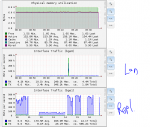I have two FreeNas 9.2.0 release boxes from two older Dell R200 1U servers. Since only 2 drives can fit in the chassis and I need a large volume and they don't make drives bigger than 4TB, I have them in RAID-0 configuration. I know, I know, raid-0 ... gasp! Well thats why theres two of these guys, since I figure one can replicate to the other which is identical config.
After formatted, the volume is about 7.1 TB. The primary has 3.94 TB of used space on it. ZFS is replicating to the other box over a dedicated 1gbps nic. In the reporting tab it looks about a constant 500mbps usage. Over an entire weekend I still don't think its done replicating.
The reason I say that is because on the second box under storage > active volumes, it shows 2.0 KB used, 756 KB available and only 823.5 KB in size.
On the main unit it shows 3.9 TB used, 2.1 TB avail and 6.1 TB in size. Its set to snapshot once a day at 8 AM and keep 2 snapshots. Under ZFS Snapshots I have two:
auto-20140315.1448-2d
auto-20140316.1448-2d
So either on the receiving side the space is not ever calculated or the replication just never completes. But when I look at the interface traffic for the nic that replication is forced over, it seems like it may be completing nightly. I'll attach a screen shot. The low point on the graph was when I was trying rsync but as you can see I wanted to abandon it since its so slow. Prior to that was ZFS replication when I gave up on it the first time.
Memory shows 6gb used out of 8gb installed. They said 1gb for every tb of storage and formatted, minus snapshots its about 7.1tb so I have an extra gig. Not doing anything crazy like dedupe or compression. Just samba and zfs replication.
After formatted, the volume is about 7.1 TB. The primary has 3.94 TB of used space on it. ZFS is replicating to the other box over a dedicated 1gbps nic. In the reporting tab it looks about a constant 500mbps usage. Over an entire weekend I still don't think its done replicating.
The reason I say that is because on the second box under storage > active volumes, it shows 2.0 KB used, 756 KB available and only 823.5 KB in size.
On the main unit it shows 3.9 TB used, 2.1 TB avail and 6.1 TB in size. Its set to snapshot once a day at 8 AM and keep 2 snapshots. Under ZFS Snapshots I have two:
auto-20140315.1448-2d
auto-20140316.1448-2d
So either on the receiving side the space is not ever calculated or the replication just never completes. But when I look at the interface traffic for the nic that replication is forced over, it seems like it may be completing nightly. I'll attach a screen shot. The low point on the graph was when I was trying rsync but as you can see I wanted to abandon it since its so slow. Prior to that was ZFS replication when I gave up on it the first time.
Memory shows 6gb used out of 8gb installed. They said 1gb for every tb of storage and formatted, minus snapshots its about 7.1tb so I have an extra gig. Not doing anything crazy like dedupe or compression. Just samba and zfs replication.

